Answers of NCERT Class 9 Maths Chapter 10 Circles
Exercise: 10.1 (Page No: 171)
1. Fill in the blanks:
(i) The centre of a circle lies in ____________ of the circle. (exterior/ interior)
(ii) A point, whose distance from the centre of a circle is greater than its radius lies in __________ of the circle. (exterior/ interior)
(iii) The longest chord of a circle is a _____________ of the circle.
(iv) An arc is a ___________ when its ends are the ends of a diameter.
(v) Segment of a circle is the region between an arc and _____________ of the circle.
(vi) A circle divides the plane, on which it lies, in _____________ parts.
Solution:
(i) The centre of a circle lies in interior of the circle.
(ii) A point, whose distance from the centre of a circle is greater than its radius lies in exterior of the circle.
(iii) The longest chord of a circle is a diameter of the circle.
(iv) An arc is a semicircle when its ends are the ends of a diameter.
(v) Segment of a circle is the region between an arc and chord of the circle.
(vi) A circle divides the plane, on which it lies, in 3 (three) parts.
2. Write True or False: Give reasons for your Solutions.
(i) Line segment joining the centre to any point on the circle is a radius of the circle.
(ii) A circle has only finite number of equal chords.
(iii) If a circle is divided into three equal arcs, each is a major arc.
(iv) A chord of a circle, which is twice as long as its radius, is a diameter of the circle.
(v) Sector is the region between the chord and its corresponding arc.
(vi) A circle is a plane figure.
Solution:
(i) True. Any line segment drawn from the centre of the circle to any point on it is the radius of the circle and will be of equal length.
(ii) False. There can be infinite numbers of equal chords of a circle.
(iii) False. For unequal arcs, there can be major and minor arcs. So, equal arcs on a circle cannot be said as a major arc or a minor arc.
(iv) True. Any chord whose length is twice as long as the radius of the circle always passes through the centre of the circle and thus, it is known as the diameter of the circle.
(v) False. A sector is a region of a circle between the arc and the two radii of the circle.
(vi) True. A circle is a 2d figure and it can be drawn on a plane.
Exercise: 10.2 (Page No: 173)
1. Recall that two circles are congruent if they have the same radii. Prove that equal chords of congruent circles subtend equal angles at their centres.
Solution:
To recall, a circle is a collection of points whose every point is equidistant from its centre. So, two circles can be congruent only when the distance of every point of both the circles are equal from the centre.

For the second part of the question, it is given that AB = CD i.e. two equal chords.
Now, it is to be proven that angle AOB is equal to angle COD.
Proof:
Consider the triangles ΔAOB and ΔCOD,
OA = OC and OB = OD (Since they are the radii of the circle)
AB = CD (As given in the question)
So, by SSS congruency, ΔAOB ≅ ΔCOD
∴ By CPCT we have,
∠AOB = ∠COD. (Hence proved).
2. Prove that if chords of congruent circles subtend equal angles at their centres, then the chords are equal.
Solution:
Consider the following diagram-

Here, it is given that ∠AOB = ∠COD i.e. they are equal angles.
Now, we will have to prove that the line segments AB and CD are equal i.e. AB = CD.
Proof:
In triangles AOB and COD,
∠AOB = ∠COD (as given in the question)
OA = OC and OB = OD (these are the radii of the circle)
So, by SAS congruency, ΔAOB ≅ ΔCOD.
∴ By the rule of CPCT, we have
AB = CD. (Hence proved).
Exercise: 10.3 (Page No: 176)
1. Draw different pairs of circles. How many points does each pair have in common? What is the maximum number of common points?
Solution:
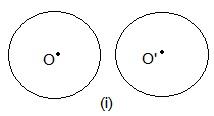
In these two circles, no point is common.
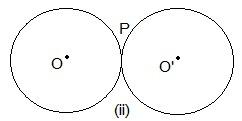
Here, only one point “P” is common.
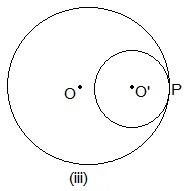
Even here, P is the common point.

Here, two points are common which are P and Q.
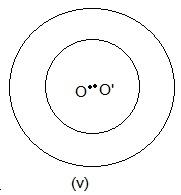
No point is common in the above circle.
2. Suppose you are given a circle. Give a construction to find its centre.
Solution:
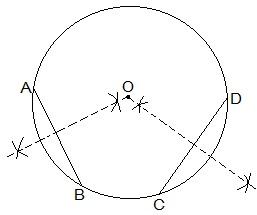
The construction steps to find the center of the circle are:
Step I: Draw a circle first.
Step II: Draw 2 chords AB and CD in the circle.
Step III: Draw the perpendicular bisectors of AB and CD.
Step IV: Connect the two perpendicular bisectors at a point. This intersection point of the two perpendicular bisectors is the centre of the circle.
3. If two circles intersect at two points, prove that their centres lie on the perpendicular bisector of the common chord.
Solution:
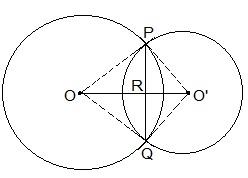
It is given that two circles intersect each other at P and Q.
To prove:
OO’ is perpendicular bisector of PQ.
Proof:
Triangle ΔPOO’ and ΔQOO’ are similar by SSS congruency since
OP = OQ and O’P = OQ (Since they are also the radii)
OO’ = OO’ (It is the common side)
So, It can be said that ΔPOO’ ≅ ΔQOO’
∴ ∠POO’ = ∠QOO’ — (i)
Even triangles ΔPOR and ΔQOR are similar by SAS congruency as
OP = OQ (Radii)
∠POR = ∠QOR (As ∠POO’ = ∠QOO’)
OR = OR (Common arm)
So, ΔPOR ≅ ΔQOR
∴ ∠PRO = ∠QRO
Also, we know that
∠PRO+∠QRO = 180°
Hence, ∠PRO = ∠QRO = 180°/2 = 90°
So, OO’ is the perpendicular bisector of PQ.
Exercise: 10.4 (Page No: 179)
1. Two circles of radii 5 cm and 3 cm intersect at two points and the distance between their centres is 4 cm. Find the length of the common chord.
Solution:
Given parameters are:
OP = 5cm
OS = 4cm and
PS = 3cm
Also, PQ = 2PR
Now, suppose RS = x. The diagram for the same is shown below.

Consider the ΔPOR,
OP2 = OR2+PR2
⇒ 52 = (4-x)2+PR2
⇒ 25 = 16+x2-8x+PR2
∴ PR2 = 9-x2+8x — (i)
Now consider ΔPRS,
PS2 = PR2+RS2
⇒ 32 = PR2+x2
∴ PR2 = 9-x2 — (ii)
By equating equation (i) and equation (ii) we get,
9 -x2+8x = 9-x2
⇒ 8x = 0
⇒ x = 0
Now, put the value of x in equation (i)
PR2 = 9-02
⇒ PR = 3cm
∴ The length of the cord i.e. PQ = 2PR
So, PQ = 2×3 = 6cm
2. If two equal chords of a circle intersect within the circle, prove that the segments of one chord are equal to corresponding segments of the other chord.
Solution:
Let AB and CD be two equal cords (i.e. AB = CD). In the above question, it is given that AB and CD intersect at a point, say, E.
It is now to be proven that the line segments AE = DE and CE = BE
Construction Steps:
Step 1: From the center of the circle, draw a perpendicular to AB i.e. OM ⊥ AB
Step 2: Similarly, draw ON ⊥ CD.
Step 3: Join OE.
Now, the diagram is as follows-

Proof:
From the diagram, it is seen that OM bisects AB and so, OM ⊥ AB
Similarly, ON bisects CD and so, ON ⊥ CD
It is known that AB = CD. So,
AM = ND — (i)
and MB = CN — (ii)
Now, triangles ΔOME and ΔONE are similar by RHS congruency since
∠OME = ∠ONE (They are perpendiculars)
OE = OE (It is the common side)
OM = ON (AB and CD are equal and so, they are equidistant from the centre)
∴ ΔOME ≅ ΔONE
ME = EN (by CPCT) — (iii)
Now, from equations (i) and (ii) we get,
AM+ME = ND+EN
So, AE = ED
Now from equations (ii) and (iii) we get,
MB-ME = CN-EN
So, EB = CE (Hence proved).
3. If two equal chords of a circle intersect within the circle, prove that the line joining the point of intersection to the centre makes equal angles with the chords.
Solution:
From the question we know the following:
(i) AB and CD are 2 chords which are intersecting at point E.
(ii) PQ is the diameter of the circle.
(iii) AB = CD.
Now, we will have to prove that ∠BEQ = ∠CEQ
For this, the following construction has to be done:
Construction:
Draw two perpendiculars are drawn as OM ⊥ AB and ON ⊥ D. Now, join OE. The constructed diagram will look as follows:

Now, consider the triangles ΔOEM and ΔOEN.
Here,
(i) OM = ON [Since the equal chords are always equidistant from the centre]
(ii) OE = OE [It is the common side]
(iii) ∠OME = ∠ONE [These are the perpendiculars]
So, by RHS congruency criterion, ΔOEM ≅ ΔOEN.
Hence, by CPCT rule, ∠MEO = ∠NEO
∴ ∠BEQ = ∠CEQ (Hence proved).
4. If a line intersects two concentric circles (circles with the same centre) with centre O at A, B, C and D, prove that AB = CD (see Fig. 10.25).

Solution:
The given image is as follows:

First, draw a line segment from O to AD such that OM ⊥ AD.
So, now OM is bisecting AD since OM ⊥ AD.
Therefore, AM = MD — (i)
Also, since OM ⊥ BC, OM bisects BC.
Therefore, BM = MC — (ii)
From equation (i) and equation (ii),
AM-BM = MD-MC
∴ AB = CD
5. Three girls Reshma, Salma and Mandip are playing a game by standing on a circle of radius 5m drawn in a park. Reshma throws a ball to Salma, Salma to Mandip, Mandip to Reshma. If the distance between Reshma and Salma and between Salma and Mandip is 6m each, what is the distance between Reshma and Mandip?
Solution:

Let the positions of Reshma, Salma and Mandip be represented as A, B and C respectively.
From the question, we know that AB = BC = 6cm.
So, the radius of the circle i.e. OA = 5cm
Now, draw a perpendicular BM ⊥ AC.
Since AB = BC, ABC can be considered as an isosceles triangle. M is mid-point of AC. BM is the perpendicular bisector of AC and thus it passes through the centre of the circle.
Now,
let AM = y and
OM = x
So, BM will be = (5-x).
By applying Pythagorean theorem in ΔOAM we get,
OA2 = OM2 +AM2
⇒ 52 = x2 +y2 — (i)
Again, by applying Pythagorean theorem in ΔAMB,
AB2 = BM2 +AM2
⇒ 62 = (5-x)2+y2 — (ii)
Subtracting equation (i) from equation (ii), we get
36-25 = (5-x)2 +y2 -x2-y2
Now, solving this equation we get the value of x as
x = 7/5
Substituting the value of x in equation (i), we get
y2 +(49/25) = 25
⇒ y2 = 25 – (49/25)
Solving it we get the value of y as
y = 24/5
Thus,
AC = 2×AM
= 2×y
= 2×(24/5) m
AC = 9.6 m
So, the distance between Reshma and Mandip is 9.6 m.
6. A circular park of radius 20m is situated in a colony. Three boys Ankur, Syed and David are sitting at equal distance on its boundary each having a toy telephone in his hands to talk each other. Find the length of the string of each phone.
Solution:
First, draw a diagram according to the given statements. The diagram will look as follows.
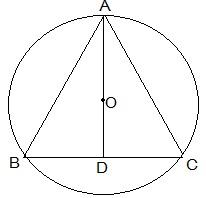
Here the positions of Ankur, Syed and David are represented as A, B and C respectively. Since they are sitting at equal distances, the triangle ABC will form an equilateral triangle.
AD ⊥ BC is drawn. Now, AD is median of ΔABC and it passes through the centre O.
Also, O is the centroid of the ΔABC. OA is the radius of the triangle.
OA = 2/3 AD
Let the side of a triangle a metres then BD = a/2 m.
Applying Pythagoras theorem in ΔABD,
AB2 = BD2+AD2
⇒ AD2 = AB2 -BD2
⇒ AD2 = a2 -(a/2)2
⇒ AD2 = 3a2/4
⇒ AD = √3a/2
OA = 2/3 AD
20 m = 2/3 × √3a/2
a = 20√3 m
So, the length of the string of the toy is 20√3 m.
Exercise: 10.5 (Page No: 184)
1. In Fig. 10.36, A,B and C are three points on a circle with centre O such that ∠BOC = 30° and ∠AOB = 60°. If D is a point on the circle other than the arc ABC, find ∠ADC.

Solution:
It is given that,
∠AOC = ∠AOB+∠BOC
So, ∠AOC = 60°+30°
∴ ∠AOC = 90°
It is known that an angle which is subtended by an arc at the centre of the circle is double the angle subtended by that arc at any point on the remaining part of the circle.
So,
∠ADC = (½)∠AOC
= (½)× 90° = 45°
2. A chord of a circle is equal to the radius of the circle. Find the angle subtended by the chord at a point on the minor arc and also at a point on the major arc.
Solution:

Here, the chord AB is equal to the radius of the circle. In the above diagram, OA and OB are the two radii of the circle.
Now, consider the ΔOAB. Here,
AB = OA = OB = radius of the circle.
So, it can be said that ΔOAB has all equal sides and thus, it is an equilateral triangle.
∴ ∠AOC = 60°
And, ∠ACB = ½ ∠AOB
So, ∠ACB = ½ × 60° = 30°
Now, since ACBD is a cyclic quadrilateral,
∠ADB +∠ACB = 180° (Since they are the opposite angles of a cyclic quadrilateral)
So, ∠ADB = 180°-30° = 150°
So, the angle subtended by the chord at a point on the minor arc and also at a point on the major arc are 150° and 30° respectively.
3. In Fig. 10.37, ∠PQR = 100°, where P, Q and R are points on a circle with centre O. Find ∠OPR.

Solution:
Since angle which is subtended by an arc at the centre of the circle is double the angle subtended by that arc at any point on the remaining part of the circle.
So, the reflex ∠POR = 2×∠PQR
We know the values of angle PQR as 100°
So, ∠POR = 2×100° = 200°
∴ ∠POR = 360°-200° = 160°
Now, in ΔOPR,
OP and OR are the radii of the circle
So, OP = OR
Also, ∠OPR = ∠ORP
Now, we know sum of the angles in a triangle is equal to 180 degrees
So,
∠POR+∠OPR+∠ORP = 180°
∠OPR+∠OPR = 180°-160°
As ∠OPR = ∠ORP
2∠OPR = 20°
Thus, ∠OPR = 10°
4. In Fig. 10.38, ∠ABC = 69°, ∠ACB = 31°, find ∠BDC.

Solution:
We know that angles in the segment of the circle are equal so,
∠BAC = ∠BDC
Now in the in ΔABC, the sum of all the interior angles will be 180°
So, ∠ABC+∠BAC+∠ACB = 180°
Now, by putting the values,
∠BAC = 180°-69°-31°
So, ∠BAC = 80°
∴ ∠BDC = 80°
5. In Fig. 10.39, A, B, C and D are four points on a circle. AC and BD intersect at a point E such that ∠ BEC = 130° and ∠ ECD = 20°. Find BAC.

Solution:
We know that the angles in the segment of the circle are equal.
So,
∠ BAC = ∠ CDE
Now, by using the exterior angles property of the triangle
In ΔCDE we get,
∠ CEB = ∠ CDE+∠ DCE
We know that ∠ DCE is equal to 20°
So, ∠ CDE = 110°
∠ BAC and ∠ CDE are equal
∴ ∠ BAC = 110°
6. ABCD is a cyclic quadrilateral whose diagonals intersect at a point E. If ∠ DBC = 70°, ∠ BAC is 30°, find ∠ BCD. Further, if AB = BC, find ∠ ECD.
Solution:
Consider the following diagram.

Consider the chord CD,
We know that angles in the same segment are equal.
So, ∠ CBD = ∠ CAD
∴ ∠ CAD = 70°
Now, ∠ BAD will be equal to the sum of angles BAC and CAD.
So, ∠ BAD = ∠ BAC+∠ CAD
= 30°+70°
∴ ∠ BAD = 100°
We know that the opposite angles of a cyclic quadrilateral sums up to 180 degrees.
So,
∠ BCD+∠ BAD = 180°
It is known that ∠ BAD = 100°
So, ∠ BCD = 80°
Now consider the ΔABC.
Here, it is given that AB = BC
Also, ∠ BCA = ∠ CAB (They are the angles opposite to equal sides of a triangle)
∠ BCA = 30°
also, ∠ BCD = 80°
∠ BCA +∠ ACD = 80°
Thus, ∠ ACD = 50° and ∠ ECD = 50°
7. If diagonals of a cyclic quadrilateral are diameters of the circle through the vertices of the quadrilateral, prove that it is a rectangle.
Solution:
Draw a cyclic quadrilateral ABCD inside a circle with center O such that its diagonal AC and BD are two diameters of the circle.

We know that the angles in the semi-circle are equal.
So, ∠ ABC = ∠ BCD = ∠ CDA = ∠ DAB = 90°
So, as each internal angle is 90°, it can be said that the quadrilateral ABCD is a rectangle.
8. If the non-parallel sides of a trapezium are equal, prove that it is cyclic.
Solution:

9. Two circles intersect at two points B and C. Through B, two line segments ABD and PBQ are drawn to intersect the circles at A, D and P, Q respectively (see Fig. 10.40). Prove that ∠ ACP = ∠ QCD.

Solution:
Construction:
Join the chords AP and DQ.
For chord AP, we know that angles in the same segment are equal.
So, ∠ PBA = ∠ ACP — (i)
Similarly for chord DQ,
∠ DBQ = ∠ QCD — (ii)
It is known that ABD and PBQ are two line segments which are intersecting at B.
At B, the vertically opposite angles will be equal.
∴ ∠ PBA = ∠ DBQ — (iii)
From equation (i), equation (ii) and equation (iii) we get,
∠ ACP = ∠ QCD
10. If circles are drawn taking two sides of a triangle as diameters, prove that the point of intersection of these circles lie on the third side.
Solution:
First draw a triangle ABC and then two circles having diameter as AB and AC respectively.
We will have to now prove that D lies on BC and BDC is a straight line.

Proof:
We know that angle in the semi-circle are equal
So, ∠ ADB = ∠ ADC = 90°
Hence, ∠ ADB+∠ ADC = 180°
∴ ∠ BDC is straight line.
So, it can be said that D lies on the line BC.
11. ABC and ADC are two right triangles with common hypotenuse AC. Prove that ∠ CAD = ∠CBD.
Solution:
We know that AC is the common hypotenuse and ∠ B = ∠ D = 90°.
Now, it has to be proven that ∠ CAD = ∠ CBD

Since, ∠ ABC and ∠ ADC are 90°, it can be said that They lie in the semi-circle.
So, triangles ABC and ADC are in the semi-circle and the points A, B, C and D are concyclic.
Hence, CD is the chord of the circle with center O.
We know that the angles which are in the same segment of the circle are equal.
∴ ∠ CAD = ∠ CBD
12. Prove that a cyclic parallelogram is a rectangle.
Solution:
It is given that ABCD is a cyclic parallelogram and we will have to prove that ABCD is a rectangle.

Proof:

Thus, ABCD is a rectangle.
Exercise: 10.6 (Page No: 186)
1. Prove that the line of centres of two intersecting circles subtends equal angles at the two points of intersection.
Solution:
Consider the following diagram

In ΔPOO’ and ΔQOO’
OP = OQ (Radius of circle 1)
O’P = O’Q (Radius of circle 2)
OO’ = OO’ (Common arm)
So, by SSS congruency, ΔPOO’ ≅ ΔQOO’
Thus, ∠OPO’ = ∠OQO’ (proved).
2. Two chords AB and CD of lengths 5 cm and 11 cm respectively of a circle are parallel to each other and are on opposite sides of its centre. If the distance between AB and CD is 6 , find the radius of the circle.
Solution:

Here, OM ⊥ AB and ON ⊥ CD. is drawn and OB and OD are joined.
We know that AB bisects BM as the perpendicular from the centre bisects chord.
Since AB = 5 so,
BM = AB/2 = 5/2
Similarly, ND = CD/2 = 11/2
Now, let ON be x.
So, OM = 6−x.
Consider ΔMOB,
OB2 = OM2+MB2
Or,

Consider ΔNOD,
OD2 = ON2 + ND2
Or

We know, OB = OD (radii)
From equation 1 and equation 2 we get

Now, from equation (2) we have,
OD2= 12 +(121/4)
Or OD = (5/2)×√5 cm
3. The lengths of two parallel chords of a circle are 6 cm and 8 cm. If the smaller chord is at a distance 4 cm from the centre, what is the distance of the other chord from the centre?
Solution:
Consider the following diagram

Here AB and CD are 2 parallel chords. Now, join OB and OD.
Distance of smaller chord AB from the centre of the circle = 4 cm
So, OM = 4 cm
MB = AB/2 = 3 cm
Consider ΔOMB
OB2 = OM2+MB2
Or, OB = 5cm
Now, consider ΔOND,
OB = OD = 5 (since they are the radii)
ND = CD/2 = 4 cm
Now, OD2= ON2+ND2
Or, ON = 3 cm.
4. Let the vertex of an angle ABC be located outside a circle and let the sides of the angle intersect equal chords AD and CE with the circle. Prove that ∠ABC is equal to half the difference of the angles subtended by the chords AC and DE at the centre.
Solution:
Consider the diagram

Here AD = CE
We know, any exterior angle of a triangle is equal to the sum of interior opposite angles.
So,
∠DAE = ∠ABC+∠AEC (in ΔBAE) ——————-(i)
DE subtends ∠DOE at the centre and ∠DAE in the remaining part of the circle.
So,
∠DAE = (½)∠DOE ——————-(ii)
Similarly, ∠AEC = (½)∠AOC ——————-(iii)
Now, from equation (i), (ii), and (iii) we get,
(½)∠DOE = ∠ABC+(½)∠AOC
Or, ∠ABC = (½)[∠DOE-∠AOC] (hence proved).
5. Prove that the circle drawn with any side of a rhombus as diameter, passes through the point of intersection of its diagonals.
Solution:

To prove: A circle drawn with Q as centre, will pass through A, B and O (i.e. QA = QB = QO)
Since all sides of a rhombus are equal,
AB = DC
Now, multiply (½) on both sides
(½)AB = (½)DC
So, AQ = DP
BQ = DP
Since Q is the midpoint of AB,
AQ= BQ
Similarly,
RA = SB
Again, as PQ is drawn parallel to AD,
RA = QO
Now, as AQ = BQ and RA = QO we get,
QA = QB = QO (hence proved).
6. ABCD is a parallelogram. The circle through A, B and C intersect CD (produced if necessary) at E. Prove that AE, = AD.
Solution:

Here, ABCE is a cyclic quadrilateral. In a cyclic quadrilateral, the sum of the opposite angles is 180°.
So, ∠AEC+∠CBA = 180°
As ∠AEC and ∠AED are linear pair,
∠AEC+∠AED = 180°
Or, ∠AED = ∠CBA … (1)
We know in a parallelogram; opposite angles are equal.
So, ∠ADE = ∠CBA … (2)
Now, from equations (1) and (2) we get,
∠AED = ∠ADE
Now, AD and AE are angles opposite to equal sides of a triangle,
∴ AD = AE (proved).
7. AC and BD are chords of a circle which bisect each other. Prove that (i) AC and BD are diameters; (ii) ABCD is a rectangle.
Solution:

Here chords AB and CD intersect each other at O.
Consider ΔAOB and ΔCOD,
∠AOB = ∠COD (They are vertically opposite angles)
OB = OD (Given in the question)
OA = OC (Given in the question)
So, by SAS congruency, ΔAOB ≅ ΔCOD
Also, AB = CD (By CPCT)
Similarly, ΔAOD ≅ ΔCOB
Or, AD = CB (By CPCT)
In quadrilateral ACBD, opposite sides are equal.
So, ACBD is a parallelogram.
We know that opposite angles of a parallelogram are equal.
So, ∠A = ∠C
Also, as ABCD is a cyclic quadrilateral,
∠A+∠C = 180°
⇒∠A+∠A = 180°
Or, ∠A = 90°
As ACBD is a parallelogram and one of its interior angles is 90°, so, it is a rectangle.
∠A is the angle subtended by chord BD. And as ∠A = 90°, therefore, BD should be the diameter of the circle. Similarly, AC is the diameter of the circle.
8. Bisectors of angles A, B and C of a triangle ABC intersect its circumcircle at D, E and F respectively. Prove that the angles of the triangle DEF are 90°–(½)A, 90°–(½)B and 90°–(½)C.
Solution:
Consider the following diagram

Here, ABC is inscribed in a circle with center O and the bisectors of ∠A, ∠B and ∠C intersect the circumcircle at D, E and F respectively.
Now, join DE, EF and FD
As angles in the same segment are equal, so,
∠EDA = ∠FCA ————-(i)
∠FDA = ∠EBA ————-(i)
By adding equations (i) and (ii) we get,
∠FDA+∠EDA = ∠FCA+∠EBA
Or, ∠FDE = ∠FCA+∠EBA = (½)∠C+(½)∠B
We know, ∠A +∠B+∠C = 180°
So, ∠FDE = (½)[∠C+∠B] = (½)[180°-∠A]
∠FDE = [90-(∠A/2)]
In a similar way,
∠FED = [90° -(∠B/2)] °
And,
∠EFD = [90° -(∠C/2)] °
9. Two congruent circles intersect each other at points A and B. Through A any line segment PAQ is drawn so that P, Q lie on the two circles. Prove that BP = BQ.
Solution:
The diagram will be

Here, ∠APB = ∠AQB (as AB is the common chord in both the congruent circles.)
Now, consider ΔBPQ,
∠APB = ∠AQB
So, the angles opposite to equal sides of a triangle.
∴ BQ = BP
10. In any triangle ABC, if the angle bisector of ∠A and perpendicular bisector of BC intersect, prove that they intersect on the circumcircle of the triangle ABC.
Solution:
Consider this diagram

Here, join BE and CE.
Now, since AE is the bisector of ∠BAC,
∠BAE = ∠CAE
Also,
∴arc BE = arc EC
This implies, chord BE = chord EC
Now, consider triangles ΔBDE and ΔCDE,
DE = DE (It is the common side)
BD = CD (It is given in the question)
BE = CE (Already proved)
So, by SSS congruency, ΔBDE ≅ ΔCDE.
Thus, ∴∠BDE = ∠CDE
We know, ∠BDE = ∠CDE = 180°
Or, ∠BDE = ∠CDE = 90°
∴ DE ⊥ BC (hence proved).















0 Comments
If you have any Misunderstanding Please let me know